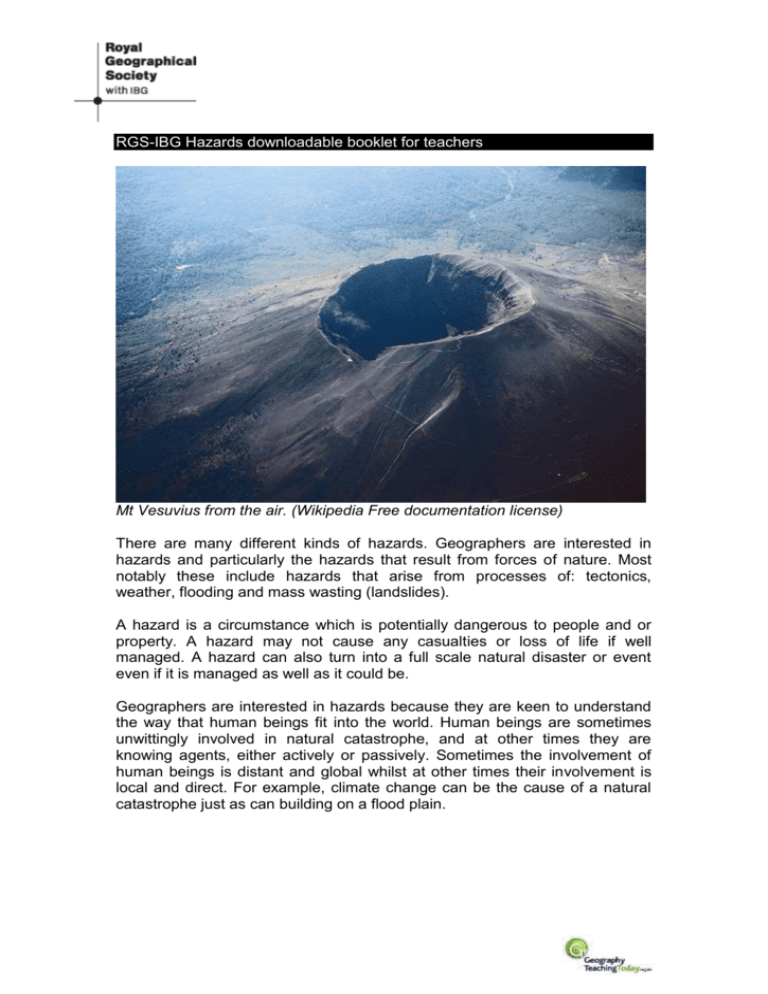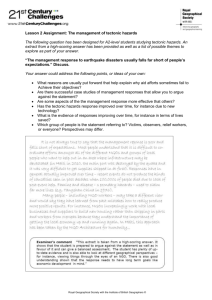Climate Change
advertisement

RGS-IBG Hazards downloadable booklet for teachers Mt Vesuvius from the air. (Wikipedia Free documentation license) There are many different kinds of hazards. Geographers are interested in hazards and particularly the hazards that result from forces of nature. Most notably these include hazards that arise from processes of: tectonics, weather, flooding and mass wasting (landslides). A hazard is a circumstance which is potentially dangerous to people and or property. A hazard may not cause any casualties or loss of life if well managed. A hazard can also turn into a full scale natural disaster or event even if it is managed as well as it could be. Geographers are interested in hazards because they are keen to understand the way that human beings fit into the world. Human beings are sometimes unwittingly involved in natural catastrophe, and at other times they are knowing agents, either actively or passively. Sometimes the involvement of human beings is distant and global whilst at other times their involvement is local and direct. For example, climate change can be the cause of a natural catastrophe just as can building on a flood plain. Geographers study hazards in terms of measuring hazardous events and modeling ways of managing such events. Geographers work with vulcanologists, meteorologists, hydrologists and all sorts of other scientists to anticipate human disasters and to prepare contingency plans for mitigating the potential impacts of such disasters. The study of hazards fits into the geography syllabus according to the earth, economic, social and political contexts of which it relates. Thus the study of tectonic hazards is typically taught with vulcanology and earthquakes, weather hazards are typically taught with the study of geographical meteorology, flooding with hydrology (the study of drainage and rivers), and mass wasting with geomorphology (the study of the earth’s processes that affect the shaping of the landscape). Students tend to enjoy studying hazards because it is pertinent and relevant to all, as depending on circumstance, each member of the class is vulnerable either in their own homes or when holidaying to a variety of risks from natural hazards. A brainstorming of the class will reveal a number of circumstances when different students were exposed to different levels of risk. Moreover, the teacher, in his or her own experience is also likely to have stories to use as a means of introducing the topic. It is very easy to make this topic exciting to students by getting them to engage with people whose lives have been affected by such events. The internet, and particularly YouTube is an excellent resource for finding small and sometimes home made videos of local events and situations. These can be downloaded using Zamzar.com, and installed into Powerpoint or Keynote presentations, so that they come at exactly the right time. Perhaps you could even contact someone who has first hand experience of one such hazard. Often there is someone within the school community who would be prepared to speak about their own experience. Experience with acts of the magnitude of an eruption or earthquake is an unforgettable experience. For many, especially living in LEDCs, it involves massive loss of life and whole communities can be very seriously affected. Try to have your students get to grips with this fact. Search YouTube and other sites for first hand accounts. There is much in the way of teaching resources for the teaching of hazards and teachers should search through their schools video/DVD resources before beginning this topic. If few resources are available it would be appropriate to seek approval from the Head teacher or Head of Department to acquire such resources, as these are instrumental in conveying the magnitude and human impact of such events. Students respond well to such material as it makes the subject real. Be mindful, however, when selecting such material to find programmes that are well suited to teaching. Some programmes can be long winded and lacking in detail that might be useful in the classroom. Be prepared to find that some of your resources are better than others, and when you find a good resource, choose this as a basis of your class programming. Some examples of good resources are listed at the bottom of this page. This module looks at tectonic hazards looking at a range of different locations in both More and Less Economically Developed countries (MEDC and LEDC). Tectonic Hazards Tectonic hazards are an interesting topic to study because they demonstrate very clearly the raw power that it at stake in the planet. Tectonic hazards include not only the potential impact of volcanoes, but also earthquakes and tsunami. The locations of such events tend to reflect continental plate boundaries where plates move against one another and are the cause of most tectonic events. It would be useful to be familiar with a plate tectonics map prior to the teaching of this topic. Such maps are available in most atlases and in various locations on the internet. Volcanoes: Volcanic hazards are an interesting topic because very often because volcanoes are often near highly populated areas. As a result the contingency plans for eruption need to be very detailed. In some places lava can be highly explosive such as with Mount Vesuvius in Italy, or it can be runny and normally produce relatively peaceful eruptions such as is the case in Hawaii. The viscosity of the lava is determined by its chemical composition. Volcanic eruptions are more easily predicted than earthquakes, as there are many indicators that a volcano tends to give before an eruption, though some volcanoes will erupt with less indicators and with a smaller lead time than others. Earthquakes: Like Volcanoes the intensity of an earthquake event can vary widely, from a small hardly felt tremor to a high intensity quake wreaking widespread damage and leading to massive loss of life. Also, like volcanoes, the damage created by an earthquake is dependent on the location of the earthquake and the population density of an affected area. However, earthquakes can impact upon people differently depending on the quality of buildings, the number of people resident in them, and the time of day at which the earthquake might hit. Earthquakes in more economically developed countries (MEDCs) tend to produce less victims, because of infrastructure, preparation and good building. Tsunami: Tsunami are in some way the most fickle of tectonic consequences, because the profile of devastation is dependent on a wide range of variables, including the nature of plate movement, and the direction which water is forced in the formation of a wave or waves. Excellent website for virtual volcanic expeditions: http://www.swisseduc.ch/stromboli/ Other sites provided to students: http://www.volcanolive.com http://volcano.und.edu http://www.geographypages.co.uk/tectonic.htm







